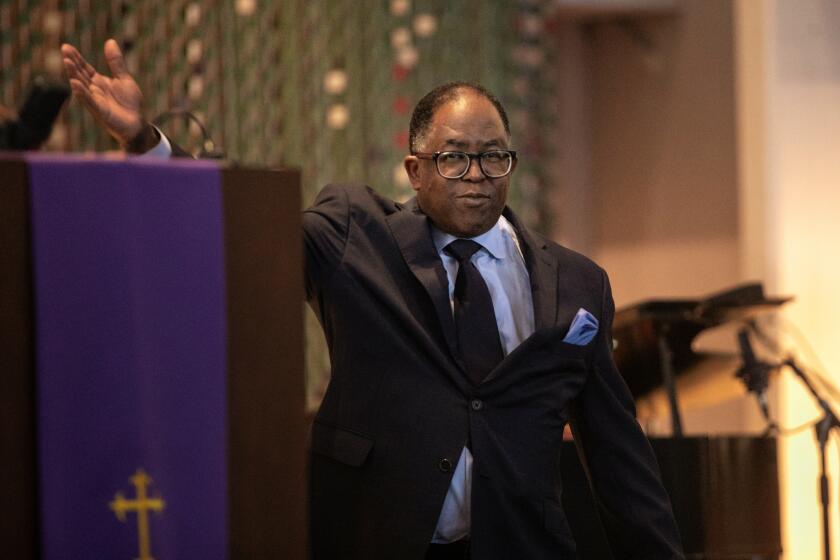Angelenos’ vision of their river is created from a made-up memory
There’s been a lot written on improving the concrete, channelized, litter-strewn Los Angeles River. No doubt the river could use some improving, but there’s also a lot of misplaced nostalgia.
To hear some people talk about restoring the river, you’d think it was once the mighty Mississippi with flotillas of steamboats churning their way upstream.
Anyone who grew up here long ago, as I did, knows the natural condition of the L.A. River — dry.
As a kid searching the river for polliwogs in the 1950s, I could bound from one side to the other without getting my feet wet. Broken glass and debris would sit all year on the baked concrete waiting for the winter to wash it away.
In time, as I traveled to great cities whose identities are inseparable from their rivers, I came to understand that our lack of a “real” one was a flaw in L.A.’s otherwise grand sense of self.
So, I’m solidly behind the people today who extol a river where vegetation abounds, wildlife flourishes and kayakers drift through the heart of the city. I just think the ebullience should be tempered by some plain talk about where the water for all this comes from.
It is an essential question about every river. If you don’t know the answer, you don’t know the river.
So, like John Hanning Speke, who trekked through unexplored Africa 160 years ago to find the source of the Nile, I found myself driven to discover the headwaters of the L.A. River.
It didn’t take long. It was mostly a matter of considering and dismissing traditional views of what makes a river.
History books tell us that long before the Los Angeles River looked like an empty freeway, it was a tiny tree-lined creek flowing through a swampy bed that in times of intense rain could become wilder than the roaring Colorado.
That river expired after the disastrous flood of 1938 when the U.S. Army Corps of Engineers built the concrete banks that still define the river channel today — barren and ugly for all but the few stormy days when they fill to the gunnels with raging water.
It’s been said that the river’s official starting point is in Canoga Park at the intersection of two concrete channels, Bell Creek and Arroyo Calabasas. But both are usually just trickles.
To find the water I had to venture to the Donald C. Tillman Water Reclamation Plant in the middle of the San Fernando Valley.
As it turns out, most of the water in the channel today is industrial and residential discharge. It’s sewage.
John Mays, a soft-spoken man about my age who also grew up around here, is engineering supervisor of the Tillman plant. In that capacity he is, in some ways, the steward of the Los Angeles River.
Mays recalls the old river of the 1950s much as I do. “It’s dry for nine months,” he said.
The Tillman plant changed that. It receives water from two giant pipes that collect the sewage from the homes of 800,000 San Fernando Valley residents. That water originally comes from as far away as the Colorado River, but mostly the Owens River, which drains the Eastern Sierra.
The sewage-filled water goes through a series of holding tanks, digesters, filters and sanitizers before crashing over a man-made waterfall into Lake Balboa. That body of water, along with two smaller ones, puts 23 million gallons of water a day into the river at Sepulveda Basin.
When Mays and I were growing up, that water was already coming to Los Angeles through William Mulholland’s aqueduct. We just didn’t see it because it was going from the houses of the San Fernando Valley straight into the city’s underground sewer system, and then on to the Hyperion Treatment plant near El Segundo.
Mays introduced me to “Brown Acres, an Intimate History of the Los Angeles Sewers.” In one section, author Anna Sklar recounts the sadly obscure story of the birth of today’s L.A. River.
Back in the 1960s, that sewer system was under duress. Episodes of intense rain would make it overflow, dumping raw sewage into the storm drains. The overload forced the city to halt all construction in the San Fernando Valley for a time.
The city engineer proposed solving the problem by drilling a huge new sewage tunnel under the Santa Monica Mountains.
But his rival in the city, an upstart retired Navy captain named Donald C. Tillman, proposed an alternative — building a water treatment plant behind Sepulveda Dam.
Tillman sold his idea to then Mayor Sam Yorty, who got President Richard Nixon to force the U.S. Army Corps of Engineers to build it.
After much delay, the plant opened in 1985, four years after Tillman had retired. Thus was born the L.A. River that modern-day enthusiasts say they want to restore.
For years, a lobby of environmentalists, urban dreamers and poets has been pushing for removal of as much concrete as possible and creation of parkways to make an urban amenity of the vast, and most of the time, empty spaces of the river.
They’re careful not to overplay the “restoration” angle, but they have a tough time finding the right words to describe a natural phenomenon that couldn’t actually exist in nature
Like Hollywood, the Los Angeles River is part of invented L.A.
There is nothing to restore; nothing to rehabilitate or renew.
The L.A. River is creation and invention. We owe its existence to our forebears — engineers who had the vision and drive to bring water here, build a city with it, then reuse it to make a dry river run.
That, in the end, is all that is native.
More to Read
Sign up for Essential California
The most important California stories and recommendations in your inbox every morning.
You may occasionally receive promotional content from the Los Angeles Times.











